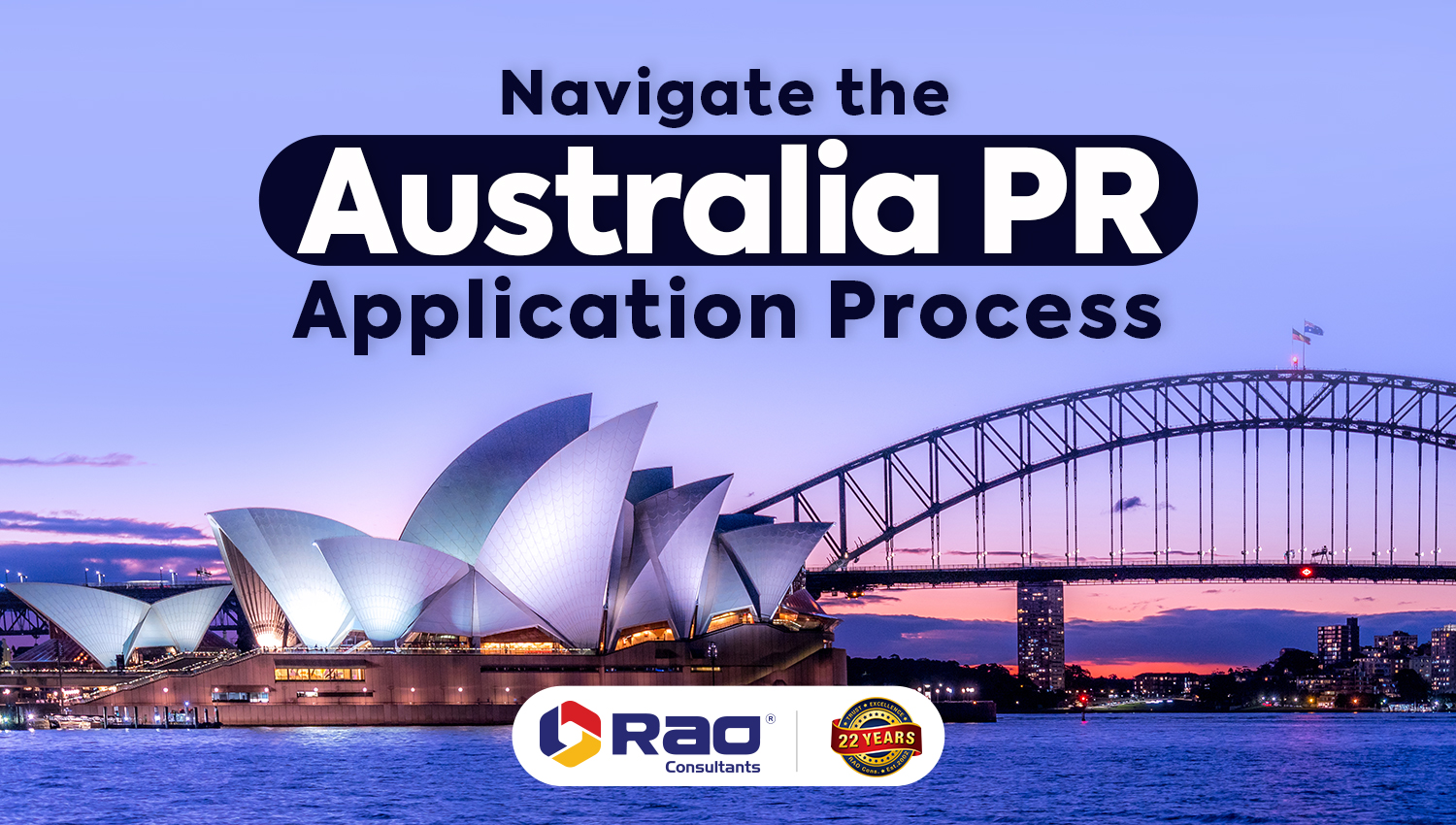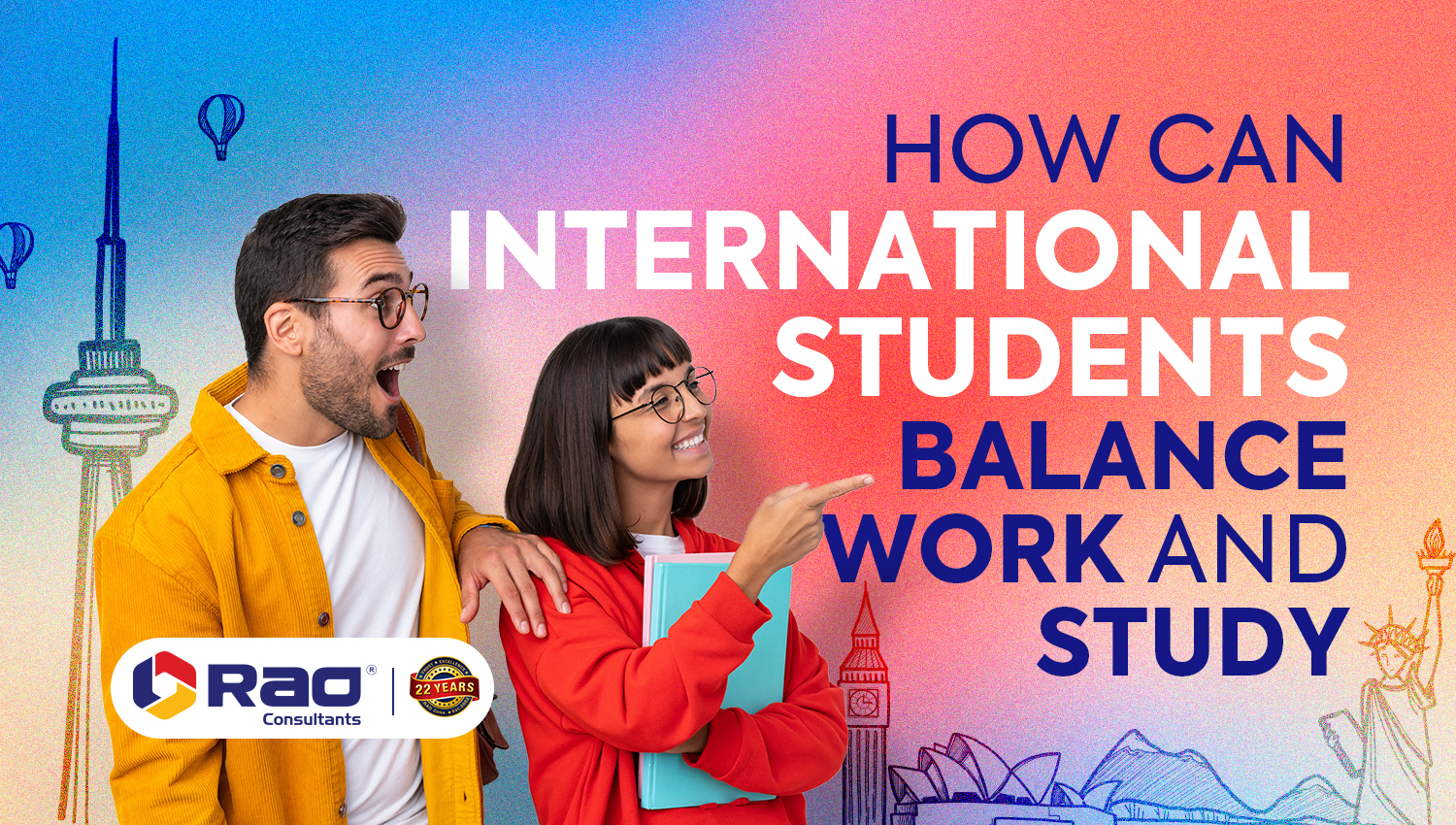
Rao Consultants
January 10, 2025
How to Navigate the Australia PR Application Process ?
![]()
Australia has established as a top choice for qualified professionals, students, and families globally. It is known for its strong economy, outstanding healthcare, high-quality education, and hospitable culture, as well as unrivalled chances for personal and professional development. The eco system provided by Australia converts it into a magnet for Indians who are looking to settle abroad and are looking for a place that provides them with a better quality of life.
Hence Australia PR has been a sought after for Immigrants but gaining Permanent Residency (PR) can be a complicated procedure that calls for a methodical and well-informed approach. The procedures, prerequisites, and advice needed to successfully complete the Australia PR Visa Process will be covered in this extensive book.
In this blog, we are going to discuss Australia Permanent Residence in detail, will shed some light on benefits of getting PR in Australia, while diving into the Australia PR Step-By-Step Process, along with the challenges that come with it and how to overcome those challenges.
Benefits of Getting Australia PR
People with permanent residency (PR) in Australia are able to live, work, and study there for as long as they choose. Significant advantages are granted by PR as opposed to temporary visas; these advantages include:
- Work Rights: Freedom to work for any employer in most fields.
- Healthcare: Access to Medicare, Australia’s government-funded healthcare system.
- Social Security Benefits: Eligibility for support services after a qualifying period.
- Citizenship Pathway: PR holders can apply for citizenship after fulfilling residency and other requirements.
- Family Sponsorship: The ability to sponsor eligible relatives for PR or temporary visas.
It is crucial that you understand these benefits prior to starting your Australia PR Visa Process. The process of obtaining a PR can go much more smoothly if you prepare beforehand.
Eligibility Criteria for Australia PR
Points are used in Australia’s PR system to make sure that candidates boost the country’s economy. The general eligibility criteria include:
Age Requirements
Applicants for skilled migration channels must normally be under the age of 45. Age has a huge impact on your scoring score, with younger candidates obtaining more points.
Points-Based Assessment
A minimum score of 65 points is necessary to submit an Expression of Interest (EOI) using the SkillSelect system. Points are granted according to:
- Age: Maximum points for those aged 25-32.
- English Proficiency: Higher scores in tests like IELTS, PTE, or TOEFL lead to more points.
- Work Experience: Both Australian and overseas work experience in a relevant field is rewarded.
- Educational Qualifications: Higher degrees, particularly those obtained in Australia, earn additional points.
- State Nomination or Sponsorship: Some states offer nomination points to applicants willing to work in specific regions.
Skilled Occupation List (SOL)
The SOL, which classifies occupations according to the demands of the Australian labor market, must include your vocation. Consistent updates guarantee conformity to financial requirements.
Health and Character Requirements
Candidates must show excellent health and character by completing a medical examination and presenting police clearance documents. The applicant’s safety and health in Australia are guaranteed by these inspections.
Australia PR Step-By-Step Process
The Australian PR application process is detailed and requires adherence to specific steps:
Step 1: Choosing the Right Visa Subclass
Finding the visa subclass that best suits your objectives and skill set is the first step. The main visa choices consist of:
- Subclass 189 (Skilled Independent Visa): For skilled workers not reliant on sponsorship.
- Subclass 190 (Skilled Nominated Visa): For applicants nominated by an Australian state or territory.
- Subclass 491 (Skilled Work Regional Visa): For those willing to live and work in designated regional areas.
Step 2: Skill Assessment
A skill assessment compares your degrees and job experience with Australian norms. Each occupation is designated an assessment authority, such as Engineers Australia or the Australian Computer Society (ACS). Early planning for this stage is crucial, as delays can disrupt the whole timetable.
Step 3: Submitting an Expression of Interest (EOI)
Once your skill assessment is complete, lodge an EOI through the Skill Select platform. The EOI outlines your qualifications, skills, and other relevant details. A higher points score increases your eligibility of receiving an invitation.
Step 4: Receiving an Invitation to Apply
If your EOI meets the requirements, you’ll receive an invitation to apply for a PR visa. Invitations are issued based on points ranking, with priority given to applicants in high-demand occupations.
Step 5: Lodging Your Visa Application
Apply for a visa online, being sure to include all necessary paperwork. These consist of identification documents, findings from skill evaluations, English language test results, and verification of job experience.
Step 6: Health and Police Checks
Undergo mandatory medical examinations and provide police clearance certificates. These checks ensure you meet Australia’s health and character requirements.
Step 7: Awaiting the Decision
Your application will be review by the Department of Home Affairs. Processing timeframes, which often range from six to 24 months, depend on the specific circumstances and the visa subclass.
Common Challenges and How to Overcome Them
The PR process is not without its challenges. Here are some main barriers and tips to address them:
Meeting the Points Threshold
For some candidates, reaching the necessary points score might be difficult. To increase your points, think about tactics like raising your English exam results, getting more job experience, or getting state sponsorship.
Selecting the Correct Visa Subclass
Choosing the incorrect visa track might lead to a loss of time and resources. Conduct extensive research or seek professional help to find the appropriate category for your specific situation.
Delays in Skill Assessment
Delays in skill evaluation might impede your application. To minimize delays, start early and make sure all essential papers are presented in the proper manner.
English Language Proficiency
Proficiency in English is a crucial component of the points exam. Invest in study materials and practice exams to get competitive IELTS or PTE scores.
Tips for a Successful PR Application
To get you Australis PR application approved and to overcome the challenges, take note of these tips:
Maintain Accuracy and Completeness
Make sure that every detail in your application is correct and backed up by the relevant paperwork. Any inconsistencies may result in rejections or delays.
Stay Updated on Policy Changes
Immigration policies and requirements change frequently. Regularly check updates from the Department of Home Affairs to stay informed.
Seek Professional Assistance
You can improve your chances of success and streamline the process by working with a registered migration agency. Experts are prepared to manage intricate instances and modifications to policies.
Prepare for Interviews or Additional Requests
Be prepared to submit extra information or attend interviews if the need arises. Prompt answers can speed up the application process.
PR Pathways for Specific Categories
Australia offers tailored pathways for different applicant categories:
Skilled Professionals
The General Skilled Migration (GSM) scheme is suited for skilled individuals in occupations listed on the SOL.
International Students
Students who graduate from Australian universities can apply for post-study work visas and employer sponsorship schemes to obtain permanent residency.
Business Investors
Entrepreneurs and investors can get a Business Innovation and Investment Visa (Subclass 188).
Family Sponsorship
PR holders and citizens can sponsor family members, including spouses, parents, and dependent children, under family reunion programs.
Processing Times and Costs
The processing time as well the cost for Australia PR vary from application to application, here is the average time and approx. cost some of these subclasses for PR takes:
Processing Times for PR Visas Vary by Subclass:
- Subclass 189: 18-19 months
- Subclass 190: 16-17 months
- Subclass 491: 5-16 months
Costs Include:
- Visa Application Fee: AUD 4,115 to AUD 4,240 for primary applicants.
- Additional Fees: Charges for dependents, health examinations, and police checks.
Conclusion
The process of obtaining permanent residency in Australia is fulfilling and has several advantages for both the individual and the workplace. Understanding the stages, fulfilling the requirements, and being well-prepared may all help make the Australia PR Visa Process manageable even if it can be complicated. Every stage, from selecting the appropriate visa subclass to overcoming obstacles, calls for meticulous preparation and close attention to detail.
Your chances of success might be further increased by seeking expert advice and keeping up with policy changes. To understand the Australia PR Step-By-Step Process in detail, get in contact with experts at Rao consultants, they can help you navigate the process and make the application filling hassle free. Getting your Australia PR will open up a world of options and establish Australia as your permanent home with perseverance and preparedness.
Share onYou May Also Like

How to Choose the Right Entrance Exam for Study Abroad ?
![]()
Studying abroad is a dream for many Indian students, but it often requires a critical step: passing the right entrance exams. Just like you need a ticket to board a flight, these exams are your entry pass into foreign universities. Whether it’s to prove your English language skills or to showcase your academic excellence, entrance […]
Read More
How Can International Students Balance Part-Time Work and Study?
![]()
Studying abroad is a dream come true for many students. when you’re juggling part-time work and study then it’s enriching, exciting, and at times, a little overwhelming. Sounds like walking a tightrope, doesn’t it? For many international students, working part-time isn’t just a choice; it’s a necessity. But how do you keep your grades up […]
Read More
Top Part-Time Jobs for International Students in Ireland
![]()
Are you planning to study in Ireland and wondering how to manage your expenses? You’re not alone. Thousands of international students ask the same question each year. The good news? Ireland offers plenty of part time job opportunities that can help ease your financial load—and even boost your resume. Think of it like riding a […]
Read More